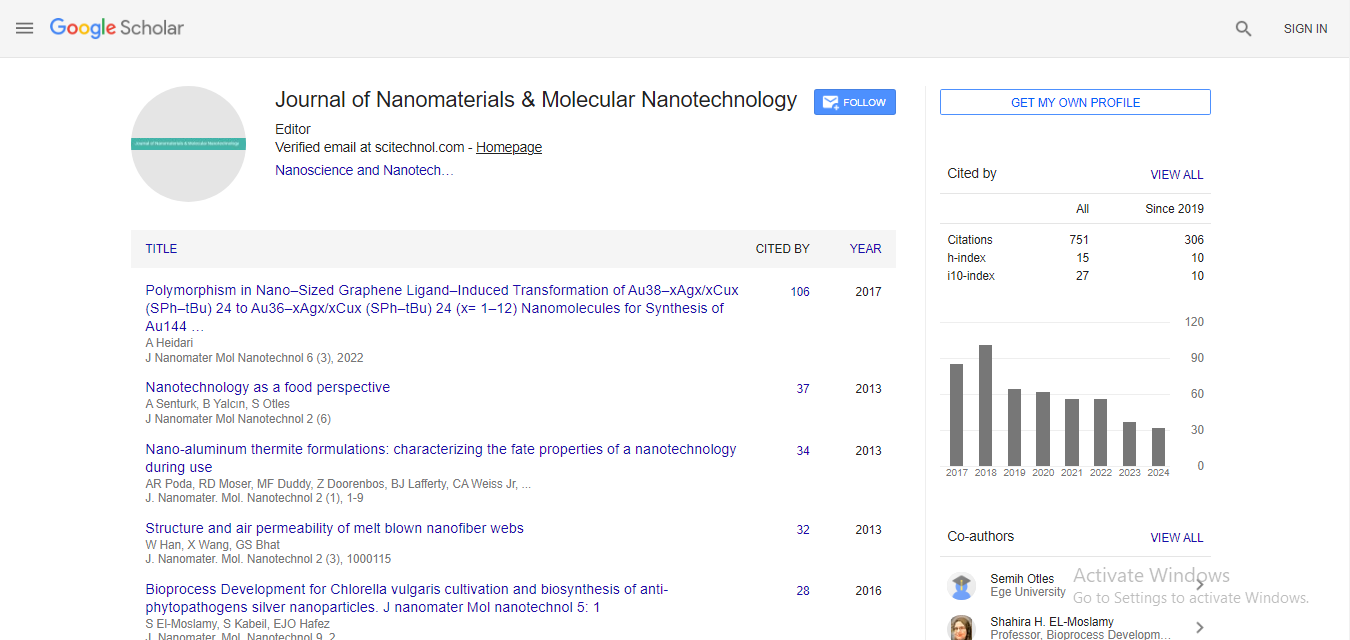Functional nanoparticles of cadmium sulfide mediated by bacteria
T.A. Voeikova,* O.A. Zhuravliova V.S. Kuligin and V.G. Debabov
National Research Cente "Kurchatov Institute", Russia
: J Nanomater Mol Nanotechnol
Abstract
Cadmium sulfide nanoparticles were obtained using cells of the bacterium Bacillus subtilis 168 (NPsCdS/ Bacillus) in the presence salts of CdCl2 and Na2S. Biogenic NPs are characterized as spherical nanocrystalline structures with a size of 5-6 nm and a zeta potential of -27 mV. The flagellin protein of the Bacillus bacterium was identified on the NPsCdS/Bacillus surface, which forms a significant stabilizing protein coating. The hydrodynamic diameter of the NPs is up to 550 nm. The ability of NPs to fluorescence in the range of 300- 450 nm at λex 270 nm is shown. Effective immobilization of NPs on various polymer carriers – aminated chloromethylated polystyrene and amino-containing polyglycidyl methacrylate microspheres, polyimide was carried out. The stability of modified polymer nanocomposites with preservation of NPs fluorescence is shown [1, 2]. The biocidal activity of NPs was established against nine test cultures of microorganisms, including strains of the genera Bacillus, Streptococcus, Enterococcus, Rhodococcus, Pseudomonas, Candida, Saccharomyces. Gram-positive bacteria and yeast showed the greatest sensitivity to NPs. The possibility of using biogenic NPsCdS as photocatalysts for discoloration of dyes of various chemical families in the presence of UV irradiation is shown. The photocatalytic activity of NPs was tested against synthetic organic dyes belonging to the families of thiazine, triphenylmethane and azodyes. The efficiency of photocatalytic discoloration is highest for dyes dyes of the triphenylmethane family and is ~85%. The possibility of triple effective use of NPsCdS/Bacillus for discoloration of a number of dyes is shown. Thus, functional NPsCdS/Bacillus stabilized by a protein coating of bacterial origin were obtained by microbial synthesis, which can serve as an alternative "green" method for obtaining nanomaterials [3] and provides their use for modifying polymer nanocomposite materials, creating antibacterial agents [4] and photocatalysts of a new generation [5]. The reported study was funded by RFBR according to the research project â?? 19-04-00088.
Recent Publications:
1. Voeikova T.Ð., Zhuravliova O.Ð., Kuligin V.S. et al. (2020) A Biomimicking Method for Fabrication of Polymer Nanocomposites and Study of Their Physicochemical Properties. Inorg Mater Appl Res 11:1397-1403.
2. Zhuravliova O.A., Voeikova T.A., Bulushova N.V. et al. (2019) Biotechnological Method of Obtaining Nanoparticles of Silver, Cadmium, and Zinc Sulfides. Physico-chemical Characteristics. Creation of Polymeric Nanocomposites. Inorg Mater Appl Res 10:1394-1400.
3. Feng Y., Marusak K.E., You L. et al. (2018) Biosynthetic Transition Metal Chalcogenide Semiconductor Nanoparticles: Progress in Synthesis, Property Control and Applications. J COCIS 38:190-203.
4. Shivashankarappa A., Sanjay K.R. (2020) Escherichia coli-based synthesis of cadmium sulfide nanoparticles, characterization, antimicrobial and cytotoxicity studies. Braz J Microbiol 51:939-948.
5. Bhadwal A.S., Tripathi R.M., Gupta R.K. et al. (2014) Biogenic synthesis and photocatalytic activity of CdS nanoparticles. RSC Adv 4:9484–9490.
Biography
Tatyana A. Voeikova, PhD, is a specialist in the field of studying the mechanisms of formation of biogenic nanoparticles using bacteria of various taxonomic groups. Her research interests include the analysis of the characteristics of biogenic metal sulfide nanoparticles, the study of the natural composition of the surface coating of particles that stabilizes nanoparticles in aqueous colloidal suspensions. In her scientific works, it is proved that the composition of the surface coating of nanomaterials is determined by the bacterial strain, is characterized by selectivity and determines many characteristics of biogenic nanoparticles. This opens up the possibility of changing the parameters of nanoparticles using various biological sources. Biogenic nanoparticles mediated by bacteria are being studied as nanofillers of polymer materials, biocidal agents of a new generation, photocatalysts for the degradation of chemically hazardous industrial waste.
 Spanish
Spanish  Chinese
Chinese  Russian
Russian  German
German  French
French  Japanese
Japanese  Portuguese
Portuguese  Hindi
Hindi 



